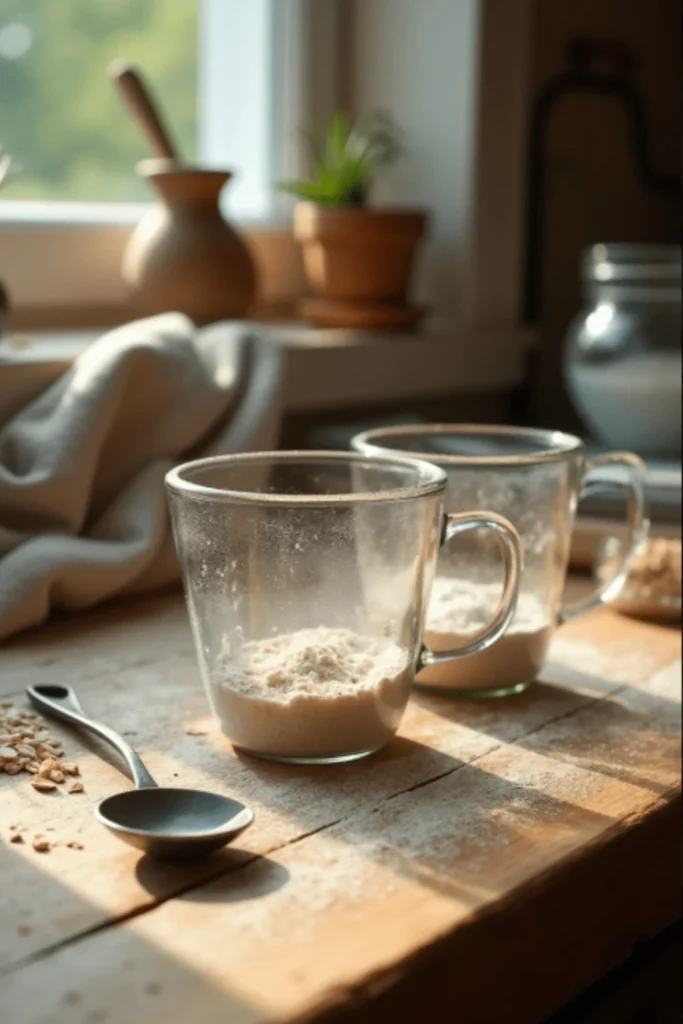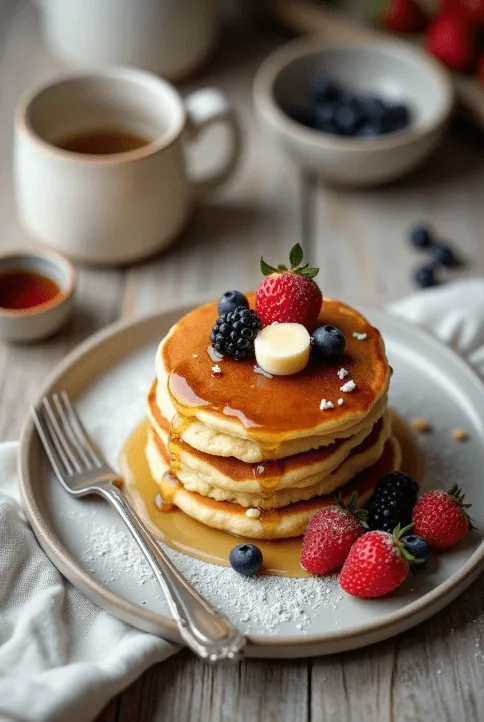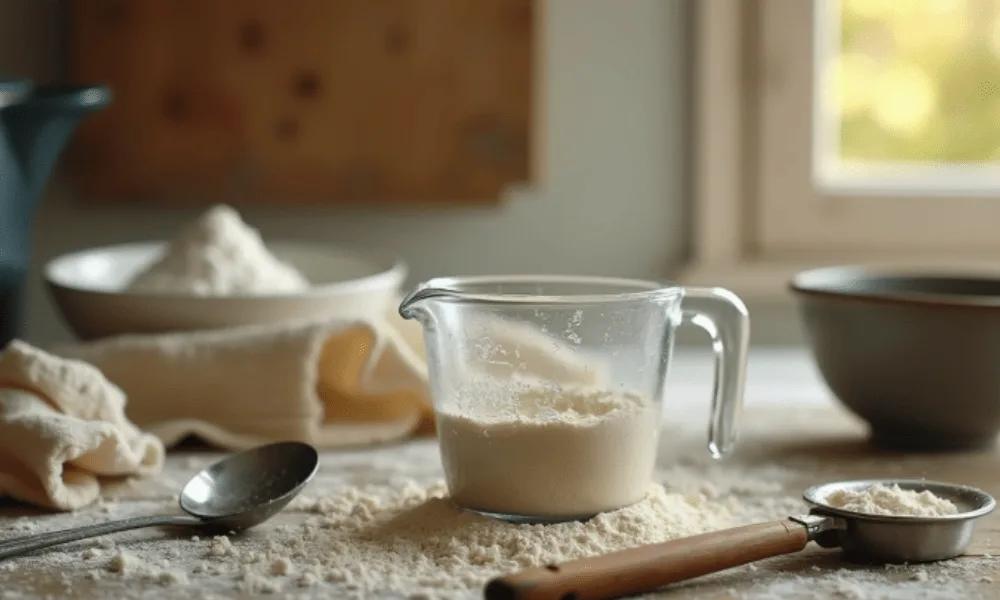Getting your kitchen measurements right is key to great cooking and baking. This quick guide covers the most common conversions plus a simple pancake recipe to put your skills to the test. Let’s make measuring easy and meals even better!
How Many Tablespoons in 1/4 Cup?
There are exactly 4 tablespoons in 1/4 cup. This conversion is one of the most frequently used in cooking and baking, making it a handy fact to remember.
Why This Matters: When scaling recipes or measuring without a 1/4 cup, knowing the tablespoon equivalent helps. For example, if a recipe requires 1/4 cup of oil, measuring 4 tablespoons ensures precision.
What Is 2/3 Cup?
Two-thirds of a cup is equal to 10 tablespoons plus 2 teaspoons. This fraction is slightly more than half a cup but smaller than 3/4 cup.
Practical Use: In recipes like sauces or dressings, where precise measurements are essential for consistency, understanding 2/3 cup ensures your dish turns out perfectly. Always use a liquid or dry measuring cup suited for the ingredient you’re measuring.
How Many Tablespoons Are in 1/3 Cup?
There are exactly 5 tablespoons and 1 teaspoon in 1/3 cup. This conversion applies to both dry and liquid ingredients.
Pro Tip: Use a standard tablespoon for accurate results. If measuring something sticky like honey, lightly grease the spoon beforehand for easier pouring and minimal waste.
How Many Tbsp Are in 1/4 Cup?
As mentioned earlier, 1/4 cup equals 4 tablespoons. This is one of the simplest conversions to remember.
Common Applications: This is particularly useful for baking, where measurements must be precise. For example, if you’re halving a recipe and need only 1/8 cup, simply measure 2 tablespoons instead.
How Many 1/3 Cups Are in a Cup?

There are three 1/3 cups in one full cup. This division makes it easier to adjust or scale recipes.
Fractional Insights: If you’re using a 1/3 cup and need to make a full cup, simply fill it three times. This method is helpful for recipes requiring exact ingredient amounts, such as soufflés or custards.
How Many Grams Is 1/3 Cup?
The weight of 1/3 cup in grams varies depending on the ingredient. For example, 1/3 cup of sugar weighs approximately 67 grams, while 1/3 cup of flour weighs about 43 grams.
Weight vs. Volume: Measuring in grams is more precise, especially in baking. Use a kitchen scale for accuracy when converting cups to grams, as densities differ between ingredients.
How to Measure a Cup Without a Measuring Cup
To measure a cup without a measuring cup, use household objects like a drinking glass, or estimate by volume. A standard cup is 8 fluid ounces or 16 tablespoons.
Creative Substitutions: For example, if you have a coffee mug that holds approximately 8 ounces, use it as your makeshift cup. Accuracy may vary, but it works in a pinch.
How to Make 1/3 Cup
To make 1/3 cup, measure out 5 tablespoons and 1 teaspoon. This is particularly useful if you don’t have a 1/3 measuring cup.
Tip for Accuracy: When measuring dry ingredients like flour, scoop and level it off with a knife to ensure exact amounts. For liquids, use a spoon with clear markings for precision.
What Is Half of 1 Tablespoon?
Half of 1 tablespoon equals 1 1/2 teaspoons. This straightforward conversion is commonly needed in recipes that require precise measurements for strong or concentrated ingredients.
Useful Example: If a recipe calls for half a tablespoon of vanilla extract, measure out 1 teaspoon and add another half teaspoon for accuracy. This is especially important in baking, where even a small variation in ingredients like extracts, oils, or spices can significantly impact the flavor and balance of the dish. Using this method ensures the perfect taste every time.
What Is Half of 1/3 Cup in Tbsp?
Half of 1/3 cup is 2 tablespoons plus 2 teaspoons. Splitting fractions like this ensures precision in scaled-down recipes.
Practical Application: When making smaller portions of a recipe, knowing how to halve measurements is key. For instance, halving a sauce recipe ensures you don’t waste ingredients.
How to Measure 1/3 Cup Without a Measuring Cup
You can measure 1/3 cup without a measuring cup by using 5 tablespoons and 1 teaspoon or by visually dividing a regular cup into three equal parts.
Estimation Tricks: If you have a full cup, fill it about one-third of the way. While this method isn’t exact, it’s often close enough for soups or stews where precision isn’t critical.
Is a Regular Spoon a Tablespoon?
No, a regular spoon is not the same as a tablespoon. Tablespoons are larger and hold about 3 times more than a standard teaspoon.
Kitchen Tools: Always use dedicated measuring spoons for accuracy. Regular spoons vary in size and can lead to inconsistent results in recipes.
How Many Tablespoons Are in 1/3 Cup of Butter?
1/3 cup of butter equals 5 tablespoons and 1 teaspoon. Butter measurements are the same whether the ingredient is melted or solid.
Tips for Measuring Butter: Use the markings on butter sticks for quick reference. Each line usually represents 1 tablespoon, making it easy to slice off the exact amount.
How to Get 1/3 Cup?
To get 1/3 cup, you can measure out 5 tablespoons and 1 teaspoon, or simply use a dedicated 1/3 measuring cup if you have one. This measurement applies to both dry and liquid ingredients and is essential for maintaining accuracy in recipes.
Quick Hack: If you don’t have a 1/3 cup measure, you can use a 1-cup measuring cup and fill it one-third of the way. For liquids, check the markings on a transparent liquid measuring cup to ensure you stop at the correct level. For dry ingredients, scoop the ingredient into the 1-cup measure until it reaches about one-third, then level it off with a straight edge for precision.
Practical Example: This is particularly useful when making sauces or batters, where accurate ingredient proportions are critical for flavor and texture. For instance, if you’re making a cake and the recipe calls for 1/3 cup of oil, using these methods ensures you’re adding the right amount, resulting in a moist, well-balanced cake.
Does 5 Tablespoons Equal 1/3 Cup?
No, 5 tablespoons alone do not equal 1/3 cup. To make a full 1/3 cup, you need 5 tablespoons plus 1 teaspoon.
Common Misconception: Many people mistakenly assume that 5 tablespoons equal 1/3 cup, but forgetting the additional teaspoon can throw off recipes, especially in baking where precision is key. Always include that extra teaspoon to ensure accurate measurements and achieve the desired results in your dish.
How Many 1/3 Make a Whole?
Three 1/3 measurements make one whole cup. This simple division of fractions is essential for scaling recipes accurately.
Fractional Tips: Understanding this concept helps when adjusting recipe portions. For instance, if a recipe calls for 1 1/3 cups of an ingredient, you can measure one full cup and then add one additional 1/3 cup. This method is especially useful when baking, where precise measurements ensure consistent texture and flavor.
What Is 1/3 of a Cup in Ounces?
One-third cup equals 2.67 fluid ounces. This conversion is particularly helpful when working with liquid ingredients that need precise measurements.
Using Ounces: To ensure accuracy, especially for liquids like oil, milk, or juice, use a measuring cup with clear ounce markings. Measuring in ounces is also useful when doubling or halving recipes, as it allows for precise adjustments without guesswork. This method is ideal for recipes like sauces, dressings, or baked goods where liquid ratios are critical.
Simple Breakfast Recipe Using 1/3 Cup Measurements

Cooking is more than just following instructions; it’s about precision and creativity. This simple pancake recipe demonstrates how using 1/3 cup measurements can lead to perfectly portioned, fluffy pancakes. Whether you’re a seasoned chef or a beginner, this recipe is quick, easy, and guarantees delicious results.
Fluffy Pancakes Recipe
Prep Time: 10 minutes
Cook Time: 10 minutes
Total Time: 20 minutes
Servings: 4 small pancakes
Ingredients:
- 1/3 cup all-purpose flour
- 1/3 cup milk
- 1 tablespoon sugar
- 1/2 teaspoon baking powder
- 1/4 teaspoon salt
- 1 egg
- 1 tablespoon melted butter
Directions:
- Prepare the Dry Ingredients: In a medium-sized mixing bowl, whisk together the flour, sugar, baking powder, and salt. Set aside.
- Mix the Wet Ingredients: In a separate bowl, whisk the milk, egg, and melted butter until well combined.
- Combine Wet and Dry Ingredients: Gradually pour the wet ingredients into the dry ingredients, stirring gently until just combined. Be careful not to overmix; a few lumps are fine.
- Heat the Skillet: Heat a non-stick skillet or griddle over medium heat. Lightly grease with butter or cooking spray.
- Cook the Pancakes: Scoop 1/4 cup of batter onto the skillet for each pancake. Cook until bubbles form on the surface and the edges look set, about 2 minutes. Flip and cook for another 1-2 minutes until golden brown.
- Serve and Enjoy: Serve the pancakes warm with your favorite toppings, such as syrup, butter, fresh fruit, or powdered sugar.
This fluffy pancake recipe highlights how simple and effective 1/3 cup measurements can be in the kitchen. The precision of these conversions ensures consistent results, and the recipe itself is versatile enough to suit any topping or side. Start your day with these delicious pancakes, and you’ll see how mastering measurements elevates your cooking experience!
FAQs About Kitchen Measurements
What is the easiest way to measure ingredients without measuring tools?
The easiest way is to use common household items. For example, a regular mug can approximate 1 cup, and a standard teaspoon or tablespoon can help measure smaller amounts. Visual estimation works for some recipes, but precision is key for baking.
How do you measure dry ingredients correctly?
To measure dry ingredients like flour or sugar, use the scoop-and-level method. Scoop the ingredient into a measuring cup, then use a flat edge (like a knife) to level off the excess for an accurate measurement.
Why are liquid and dry measuring cups different?
Liquid measuring cups are designed with spouts to prevent spilling and measure fluid ounces, while dry measuring cups allow for leveling off ingredients like flour or sugar for precision.
Related Reading for Accurate Measurements
For those looking to refine their baking skills, explore our guide on how to make accurate measurements for baking. This resource provides essential tips to ensure your recipes turn out perfectly every time.
Conclusion
Accurate kitchen measurements are essential for culinary success, whether you’re whipping up a batch of fluffy pancakes, baking a decadent cake, or preparing a savory sauce. Precision not only ensures the perfect balance of flavors but also helps you achieve consistent results every time you cook. By mastering common conversions, such as 1/3 cup to tablespoons or cups to grams, you’ll find it easier to follow recipes, scale portions up or down, and even troubleshoot kitchen challenges.
Moreover, accurate measurements can save you valuable time and reduce food waste by preventing mistakes caused by guesswork. They also give you the confidence to experiment with new recipes and techniques, knowing that you’ve got the foundation right. The included pancake recipe is a perfect starting point for practicing these conversions in a fun and delicious way. Once you see how mastering measurements leads to flawless pancakes, you’ll feel empowered to tackle more complex recipes with ease.
Cooking is not just about following instructions—it’s about building skills and enjoying the process. So grab your measuring tools, embrace the art of precision, and watch how your culinary creations improve. Whether you’re cooking for your family, impressing guests, or just treating yourself, accurate measurements are your key to success. With practice and a little creativity, you’ll soon be cooking with confidence and achieving results you’re proud of!


